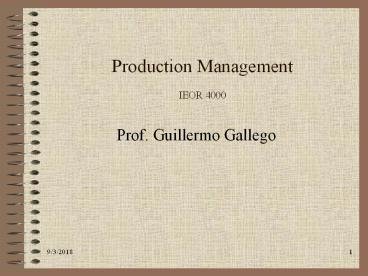Production Management IEOR 4000 - PowerPoint PPT Presentation
Title:
Production Management IEOR 4000
Description:
Initially lack of data and computing power and management ... Just-in-Time. Reengineering. Supply Chain Initiatives. EDI, ECR, VMI. Sharing Demand Information ... – PowerPoint PPT presentation
Number of Views:281
Avg rating:3.0/5.0
Title: Production Management IEOR 4000
1
Production ManagementIEOR 4000
- Prof. Guillermo Gallego
2
Self Introduction
- Professor and Chairman of Industrial Engineering
Operations Research Dept. - Research interest in Supply Chain Management and
Revenue Management - Published over fifty papers
- Visiting professor at Stanford GSB 1997-1997
- Visiting scientist at IBM 1999-2003
- Senior editor for MSOM and POM.
- Consultant for Lucent Technologies
3
Topics to Be Covered
- Today History of Operations Management,
Production systems, Recent trends. - Deterministic models
- EOQ, EPQ, JRP, ELSP, APP, MRP, JIT
- Forecasting
- MA, ES, MMFE.
- Stochastic models
- Newsvendor model.
- Serial Systems Supply chain models.
- Distribution and Assembly Systems
4
Benefits to Be Obtained
- Understand production and inventory systems.
- Understand basic tradeoffs between
- Holding costs versus fixed costs.
- Holding costs versus service levels.
- Efficiency versus variety
- Learn about
- Production/inventory management techniques
- Forecasting
- Risk and sensitivity analysis
- Supply chain design issues
5
Intended Audience
- A required course for MS degree in IE and MS in
OR. - Students entering the fields of industrial
engineering or supply chain management. - Students interested in learning how to develop
models. - Production and general managers wishing to
understand models behind decision support
systems.
6
Prerequisites
- Working knowledge of calculus.
- A good course in probability and statistics. This
can be taken concurrently. - A deterministic models course (linear
programming). This can be taken concurrently. - Knowledge of Excel or equivalent spreadsheet
program. - Willing to work hard.
7
Evaluation
- Assignments 15
- Midterm 40
- Final 45
8
Todays Lecture
- Motivation
- History of Operations Management
- Recent Trends in Inventory Management Types of
Manufacturing Systems - Strategic and Hierarchical Planning
- Inventory Classification
- Relevant Costs
- Performance Measures
9
Motivation
- Operations is concerned with the transformation
of inputs into goods and services - Primary business function together with marketing
and finance - It involves the greatest portion of the company's
employees and capital assets. - Activities include
- plant management, product development, process
engineering, facility layout, production and
capacity planning, quality control, inventory
control, product distribution
10
History of Operations Management
- Life before organized production
- The industrial revolution
- Invention of the steam engine.
- Specialization of labor
- Interchangeable parts
- Assembly line (Ford)
- Product variety (GM)
11
Scientific Method
- The Principles of Scientific Management by
Frederic Taylor - Experiment with methods to find best way to
perform a job - Improve efficiency results in
- Lower costs to companies
- Higher wages for laborers
- Better and less expensive products for consumers
12
Management Science
- Also known as Operations Research
- Use of models, mathematics and statistics to
solve business problems - Objectives, Decision Variables, Constraints
- Initially lack of data and computing power and
management skepticism - ERP systems and better trained management opens
possibilities
13
Recent Trends
- Plant Automation
- Just-in-Time
- Reengineering
- Supply Chain Initiatives
- EDI, ECR, VMI
- Sharing Demand Information
- Demand Lead Times
- Changing the Givens
14
Operations Systems
- Job Shops
- Low volume high variety
- Custom made goods
- Repetitive Manufacturing
- High volume low variety
- Televisions, roller skates
- Batch Manufacturing
- Medium volume and variety
- Hand tools, drills
- Processes and Projects
- Refineries, ship manufacturing
- Non Manufacturing
15
Strategic and Hierarchical Planning
- Strategic Planning
- Product line, location, size and number of plants
and warehouses - Tactical Planning
- Size of workforce, rate of production,
distribution of goods - Operational Control
- Assignment of work to stations, short term
inventory control issues.
16
Impact of Inventories
- Firm level
- One third of the current assets
- 2.5 years of after-tax profits
- Potential to increase profits and reduce costs
- Macro level
- Accumulation at peak of cycle
- Downscale production, slash prices, some firms do
not survive - Low inventories at bottom of cycle
- Increase production, hire people, additional
increase in demands, higher prices, etc.
17
Inventory Classification
- Functional
- Cycle stock
- Congestion stock
- Safety stock
- Anticipation inventories
- Pipeline inventories (WIP)
- Time
- Input, WIP, In-transit, Output.
18
Classification by Value
- Sort by annual dollar volume
- Most firms
- 20 SKUs account for 80 usage
- 30 SKUS account for 15 usage
- 50 SKUS account for 5 usage
- ABC analysis treats high dollar volume parts
differently.
19
Characteristics of Inventory Systems
- Demand
- Constant versus variable
- Known or unknown
- Lead Times Constant versus random
- Review Times Periodic versus continuous review
- Excess Demand Lost versus backlogged
- Changing Inventory Perishable, obsolescence
- Structure of System Assembly, distribution, etc.
20
Relevant Costs
- Procurement costs fixed and variable
- Holding costs Warehousing, insurance,
opportunity cost - Stockout or penalty costs
- Cost of changing the production rate hiring,
firing, overtime - System control costs
21
Performance Measures
- Probability of not stocking out during lead time
- Fill rate Proportion of demands that are met
directly from stock - Average number of backorders
- Turnover ratio Ratio of throughput to average
inventory

